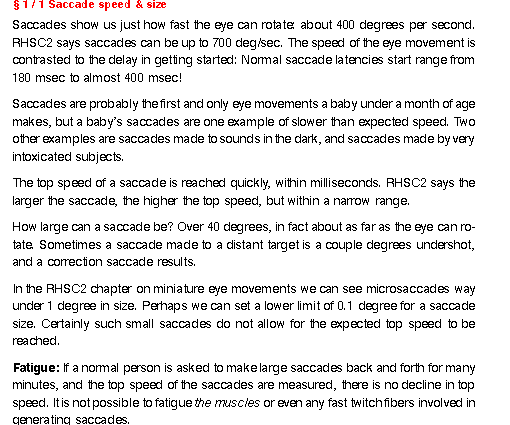
Saccades are frequent rapid long-latency voluntary ballistic conjugate accurate foveating eye movements.
You make saccades about 3 times per second; they can be voluntarily suppressed during such activities as aiming a gun or threading a needle. Many of the 3 per sec saccades may be very small... [On the other hand, during the day, you're almost never making smooth pursuit eye movements.]

Saccades are everywhere: RHSC2 index has 33 entries under "saccade"!
Saccade waveforms
Appearance of saccadic waveforms: all saccade rotation-vs-time plots fall
on the main sequence curve. See first figure of RHSC2 chpt 4. Note
the perfect stopping of saccades.
Is the quick phase of nystagmus a saccade? If it quacks like a duck, it's a duck... So it seems, by the waveform, on the main sequence. But quick phase nystagmus is NOT voluntary, so by that criteria is not a saccade.
How small can a saccade be? Wait until the lecture on minature
eye movements... less than a degree, maybe 0.1 degrees...
No sign of fatigue in saccade speed.
Why make saccades?
A necessary stimulus for a saccade is a position error. But there are many
position errors in the visual field. Therefore a sufficient stimulus is a conscious
or subconscious desire to shift attention to a particular target away from the
fovea. Examples: looking at a light that starts blinking in your periphery,
or making an eye movement to a sound in the dark.
Saccades shift the spotlight of attention. Example: reading is a series of horizontal saccades (except if you're reading comics, then some vertical saccades are mixed in, as you look from the bubbles to the faces...)
See article by Pettigrew and Wallman: Saccades stir up nutrients
in the bird retina, from the pectin supply, out of the optic nerve. Nature
343: 362 (1990).
Also, saccades can be made fairly well to sounds, with the eyes closed.
Are saccades the stuff of REM dreaming?
Are saccades really ballistic?
Yes, saccades will be made to targets that disappear before the eye finishes
its movement. And if another target appears in the meantime, normally the eye
will make the original saccade then make another saccade to the new target.
saccade stimulus from sound in the dark: auditory-visual transformation
demo with prism goggles and ballistic pointing; pointing can be with eyes closed.
Saccades to moving targets:
Hallett & Lightstone experiment. Vision Research 16:
99 (1976)
See references on RHSC2 p. 518: If a second target appears above the trajectory
of a horizontal saccade, then the eye will make a correct saccade to
the target, in spite of the fact that the retinal error was purely vertical.
Implies that the saccade generator can take into account the movement of the
eye.
Saccade to a computed target. RHSC2 page 361: craniotopic coordinates
Pulse-step control: see next lecture...
Neural model for control of saccades
see Evinger, Kaneko and Fuchs, JNP 1982
microstimulation of OPN region can stop or interrupt saccades.
SEE �12.4 page 360 of RHSC2 for discussion of model.
And see Fig 12.18 of RHSC2. Where's the integrator and how
does it work?
How is DURATION coded? By position, from Superior Colliculus.
The signal gates the integrator neuron: Figure adapted from Fuchs Kaneko &
Scudder (1986) and Cullen & Guitton (1997a):
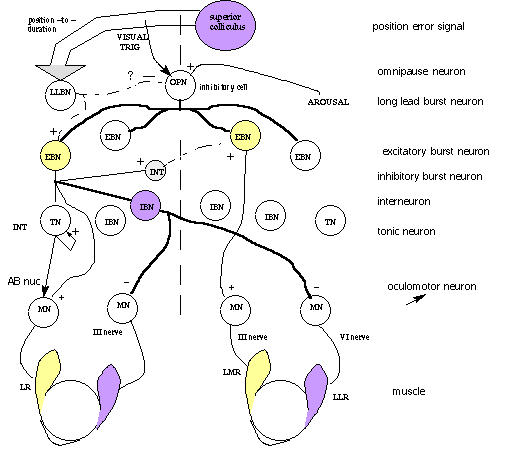
Notes:
OmniPauseNeurons: they inhibit burst neurons until a saccade is "authorized."
Does the duration of their pause control saccade duration? OPNs are less active
during times of "mental fatigue".
Burst Neurons: Long Lead Burst neurons carry the position-to-duration
signal from the superior colliculus to saccade control.
IBN-makes inhibitory monosynaptic contact with contralateral
abducens, and with the ipsilateral MR. see fig 9.18 RHSC2, where radius determines
duration of D burster...
Tonic neurons: an integrator of EBN excitatory burst neuron. The contra MR is excited by an crossover connection through an interneuron.
Saccades and brain lesions Can enough of the brain be ablated to eliminate saccades? What about the notion that no particular stroke can stop eye movements?
Reading Leigh & Zee saccade chapter...p. 51 "...This
result implies that, in monkeys, the colliculus can provide the visual input
necessary for the accurate guidance of saccades even when striate cortex
is destroyed."
Leigh & Zee say there are inhibitory burst neurons in
the model...
Leigh & Zee, p. 46: BRAIN STEM CONTROL: caudal pons for horizontal saccades,
rostral mesecephalon for vertical.
LZ3 chapter 6, "Control of conjugate eye movements" has Fig 6-1 showing IBN and EBN in action. It suggests that the EBN affects the contralateral MR!
FRONTAL EYE FIELDS: control of contralateral eye movements.
(cortical area 8, premotor) PROJECT TO BASAL GANGLIA
Mountcastle & PPC neurons: related to attention, instead of specific motor output.
Patients with extrapyramidal disorders frequently have saccadic abnormalities.
Ablation: roles of superior colliculus, frontal eye fields: If both the FEFs and superior collicului are lesioned in a primate, then, "...a striking saccadic paralysis ensues. Such animals virtually cease making saccadic eye movements and appear to lose the ability to voluntarily move their eyes, although they can still attend to the visual field as shown by their ability to acquire objects of interest with their hands."
If gaze holding is impaired, then nystagmus results.
The long and winding road: Delay of saccades
Saccades have longer latency from stimulus to initiation than does smooth
pursuit!
RHSC2 p. 76, saccadic latency
Considerable variability, from 120 msec to 350 msec, mostly longer than
200 msec. "Rather this delay seems to have to do with the task of deciding
whether in fact there is a target at all, and if so, whether to look at it,
something altogether more high level and complex."
Saccadic delay can be greater than average because of
* occurrence of a prior saccade
*dim illumination
*need to make large or small saccade
*p. 83. age, schizophrenia!
*saccade to auditory stimulus should be shorter?
What can make delay zero? prediction. but not in
monkeys!
REALLY ZERO? What about the phototransduction delay? See Fig 4.12.
micro-saccades as a clock for refractory period. And the quick phase of nystagmus can also inhibit or be a refractory stimulus for a subsequent saccade. but see page 83 "...not in the expected manor..." a true saccade can override nystagmus?
Saccadic refractory period
A saccade cannot be interrupted, once eye movement is started, but once
the saccade has ended (the fovea is fixed on a new target), how soon can another
saccade begin? You can see from Fig 4.1, it is about 180 msec.
Saccadic procrastination
See RHSC2 chpt 12, page 370, Saccadic Procrastination.
high-level decision must be made about what to look at
(saccades in frogs?)
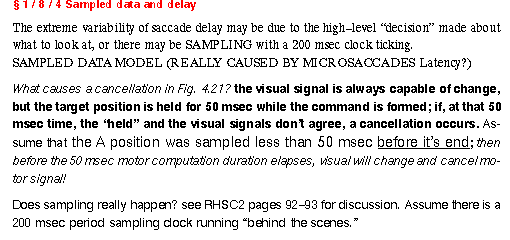
Variability of saccade latency, saccade cancellation,
and the sampled data model
The 200 msec range of varibility for normal saccade latency might be explained
by reference to "high level voluntary decision making" about what
to look at by change of foveation. But that labelling just begs the question
of mechanism. Here we focus on L. Stark's sampled data model. L.
Stark, Neurological Control Systems, Plenum Press, New York (1968).
For electrical engineers "sample" refers to one half the function of a sample-and-hold circuit. If you look online at the first diagram on the data sheet for the National Semiconductor LF398 S/H chip you will the basic idea: an analog switch makes brief contact with the signal to sample, but long enough to charge up a small capacitor (acting as a fast integrator) on the input to a "unity gain voltage follower" op amp. The other choice for the analog toggle switch input is the fed-back output of the UGVF. Positive feedback with gain of 1! The UGVF has a v. high impedance input that doesn't give the little capacitor much change to discharge over some number of milliseconds while the capacitor is disconnected from the signal.
Here is another website discussion of S/H, from Oberlin
The clock input to a S/H circuit is a low-duty-cycle pulse train. It is of interest that the variability range is about 180 msec latency to 380 msec, suggesting the sample clock rate should be 5Hz.
The implication of a sampled data system is that the saccade control system "sees" the target only briefly every 200 msec. The extreme cases: if the target changes position just before the signal is sampled then the minimum 180 msec latency ensues. If the target changes position just after a clock pulse the system will have to wait 200 msec for another sample, and the latency is increased to 380 msec. What happens if the late target stays on for only 100 msec? Then the system won't see that target and the saccade will be skipped or "cancelled".
See RHSC2 Fig 4.19 for the raw data.
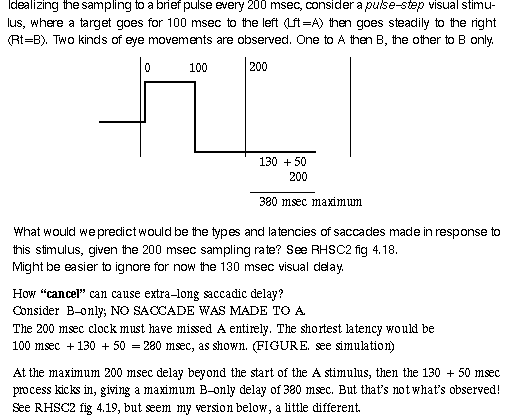
What can cause a cancellation, such as seen in RHSC Fig 4.21?
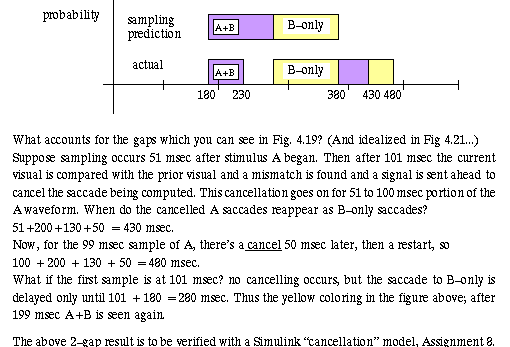
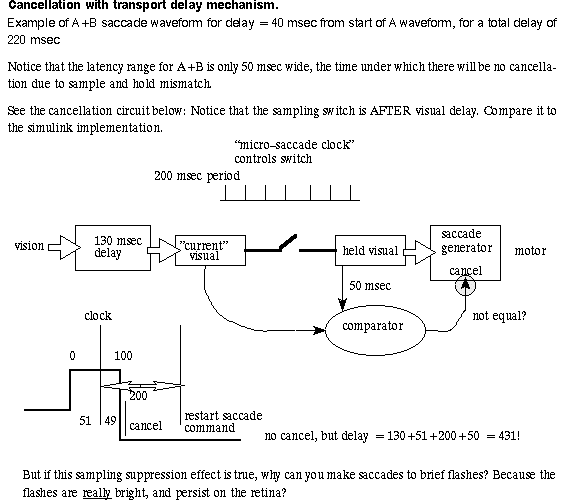
Saccadic suppression
Saccadic suppression: Look in a hand-held mirror: Can you see
your own saccades? Fixate on one eye then make a saccade to the other. Compare
to smooth pursuit viewing: rotate the mirror instead of the head.
Is SS why smooth pursuit can't be made to targets moving faster than 40�/sec? It's at least partly due to increased retinal activity, by movement of the background...the background masks the center test spot. RHSC2 p 318.
Experiments with no eye movements. Fig 11.3. Has someone tested
this with plain background...? or is that a contradiction in terms?
photoreceptor shear cannot account for all SS, because SS starts before movement
starts (Fig 11.1). Is this a role for proprioception? no evidence...
WHAT ABOUT BLINKS? Do they suppress vision?
IN THE EXPERIMENT BELOW A CENTRAL SPOT IS MOVED FROM RIGHT TO LEFT. THE TIME OF THE START OF THE MOVEMENT IS T=0. (HOW LONG DOES THE MOVEMENT TAKE? the length of the movement is about 3.2� at "saccade-like speed" so the stimulus movement is over in about 10 msec or less.) WITH RESPECT TO T=0, A SPOT A F IS FLASHED. SEE ITS VISIBILITY CHARTED BELOW. (How long does the test flash last? very brief, I guess; less than 10 msec.)
It's OK that intended eye movement suppresses vision, but
What about saccadic suppression and fig 11.2 & 11.3?
saccadic suppression without eye movements
compare to blink vs ext. occlusion suppression...
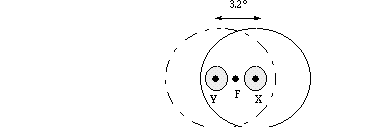
A 10 degree adapting field (pattern?) with a central test region is moved suddenly from X to Y.
The subject is asked to fixate at F. The graph below shows the "visibility" of the test flash as a
function of time wrt to movement of the background.
The judgement of the observer occurs a second or so after all of this is over. The response then occurs long after these stimuli.
NO SACCADE IS INVOLVED HERE.
try to explain it! another suppression / feedforward cancellation mechanism!
time axis on Fig 11.3: test flash time - bkgd time
negative if test flash occurs before bkgd move!
Think of when the judgment is made...
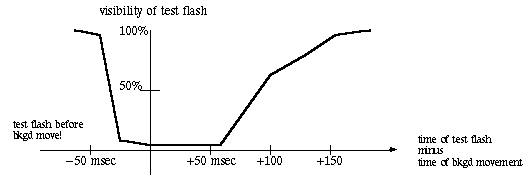
30 or 3� movement at 300�/sec is a 100 msec movement?!
What can explain it?
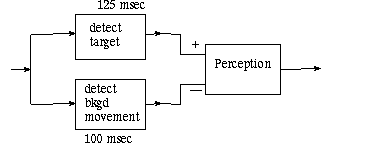
THIS IS NOT TO SAY THAT NO ADDITIONAL SUPPRESSION OCCURS BECAUSE
OF THE EYE MOVEMENT ITSELF.
...more information
David A. Robinson, "The systems approach to the oculomotor system", Vis. Res. 26: 91-99 (1986).
Summary
* stimulus for: (can be to sounds) position error
* Qualities
frequent, rapid, ballistic, long-latency, accurate, voluntary.
represent position change = attention shift (foveal)
* Sizes
* Pulse-step control
position error to duration needed
an integrator of the pulse gives new position
accuracy & match
* Sensory-Motor Transformation
superior colliculus
* FKS 85 model / KEC 97 model
note similarity to VOR control...SC takes place of SCC
Superior colliculus generates duration pulse.
pulse from burst neuron
crossover by IBN
tonic = integrator
Omni-pause neurons & fatigue
* Frontal eye fields can also generate saccade pulse signal
if superior colliculus and FEF are ablated saccades cease
* latency
reasons for longer saccades
Variability: micro saccades as a clock
Young & Stark: sampled data system & Vogelstein model
* Saccadic suppression
visual masking by movement of the textured backgd...NO eye mov!
PRECOGNITION? CHPT 11 FIGURES.
----------------
Various outlines from the prior
lectures...
microsaccades
REM sleep and paralysis upon awakening
QUALITIES of saccades
PULSE STEP CONTROL
DELAY
NEURAL MODEL
central STRUCTURES
SUPPRESSION
saccade + tracking + vergence (a saccade superimposed)
central structures
stimulate superior colliculus (tectal-spinal pathway) and produce saccades
what happens when you ablate it?
Saccades & attention, fixation
Saccades & Cognition (last couple pages of RHSC2 chpt 4)
How long does one linger on a word of text?
Larry Stark: Scan paths...
Chinese vs English text--saccades about the same...
Can people count objects close together when saccades can't be effectively made
between the objects? (bottom of page 99)